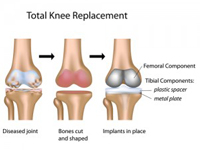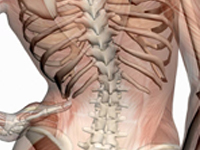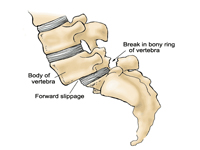Knee Replacement
 Knee replacement, or knee arthroplasty, is a surgical procedure to replace the weight-bearing surfaces of the knee joint to relieve the pain
and disability of osteoarthritis. It may be performed for other knee diseases such as rheumatoid arthritis and psoriatic arthritis. In patients with severe deformity from advanced rheumatoid arthritis, trauma, or long standing osteoarthritis, the surgery may be more complicated and carry higher risk. Osteoporosis does not typically cause knee pain, deformity, or inflammation and is not a reason to perform knee replacement.
Other major causes of debilitating pain include meniscus tears, cartilage defects, and ligament tears. Debilitating pain from osteoarthritis is much more common in the elderly.
Knee replacement surgery can be performed as a partial or a total knee replacement. In general, the surgery consists of replacing the diseased or damaged joint surfaces of the knee with metal and plastic components shaped to allow continued motion of the knee.
The operation involves substantial postoperative pain, and includes vigorous physical rehabilitation. The recovery period may be 6 weeks or longer and may involve the use of mobility aids (e.g. walking frames, canes, crutches) to enable the patient's return to preoperative mobility.
Knee replacement, or knee arthroplasty, is a surgical procedure to replace the weight-bearing surfaces of the knee joint to relieve the pain
and disability of osteoarthritis. It may be performed for other knee diseases such as rheumatoid arthritis and psoriatic arthritis. In patients with severe deformity from advanced rheumatoid arthritis, trauma, or long standing osteoarthritis, the surgery may be more complicated and carry higher risk. Osteoporosis does not typically cause knee pain, deformity, or inflammation and is not a reason to perform knee replacement.
Other major causes of debilitating pain include meniscus tears, cartilage defects, and ligament tears. Debilitating pain from osteoarthritis is much more common in the elderly.
Knee replacement surgery can be performed as a partial or a total knee replacement. In general, the surgery consists of replacing the diseased or damaged joint surfaces of the knee with metal and plastic components shaped to allow continued motion of the knee.
The operation involves substantial postoperative pain, and includes vigorous physical rehabilitation. The recovery period may be 6 weeks or longer and may involve the use of mobility aids (e.g. walking frames, canes, crutches) to enable the patient's return to preoperative mobility.
Total Hip Replacement
 Hip replacement is a surgical procedure in which the hip joint is replaced by a prosthetic implant. Hip replacement surgery can be performed as a total replacement or a hemi (half) replacement. Such joint replacement orthopaedic surgery is generally conducted to relieve arthritis pain or in some hip fractures. A total hip replacement (total hip arthroplasty) consists of replacing both the acetabulumand the femoral head while hemiarthroplasty generally only replaces the femoral head. Hip replacement is currently the most common orthopaedic operation, though patient satisfaction short- and long-term varies widely.
Hip replacement is a surgical procedure in which the hip joint is replaced by a prosthetic implant. Hip replacement surgery can be performed as a total replacement or a hemi (half) replacement. Such joint replacement orthopaedic surgery is generally conducted to relieve arthritis pain or in some hip fractures. A total hip replacement (total hip arthroplasty) consists of replacing both the acetabulumand the femoral head while hemiarthroplasty generally only replaces the femoral head. Hip replacement is currently the most common orthopaedic operation, though patient satisfaction short- and long-term varies widely.
Spine Decompression
 Spinal decompression is the relief of pressure on one or many pinched nerves (neural impingement) of the spinal column.
Spinal decompression can be achieved both surgically and non-surgically and is used to treat conditions that result in chronic back pain such as disc bulge, disc herniation,sciatica, spinal stenosis, isthmic and degenerative spondylolisthesis.
Spinal decompression is the relief of pressure on one or many pinched nerves (neural impingement) of the spinal column.
Spinal decompression can be achieved both surgically and non-surgically and is used to treat conditions that result in chronic back pain such as disc bulge, disc herniation,sciatica, spinal stenosis, isthmic and degenerative spondylolisthesis.
Spondylolisthesis
 Spondylolisthesis is the forward displacement of a vertebra, especially the fifth lumbar vertebra, most commonly occurring after a break or fracture. Backward displacement is referred to as retrolisthesis.
The variant "listhesis," resulting from division of this compound word, is sometimes applied in conjunction withscoliosis. These "slips" occur most commonly in the lumbar spine. Spondylolysis (a defect or fracture of thepars interarticularis of the vertebral arch) is the most common cause of spondylolisthesis, which should not be confused with a slipped disc, in which one of the spinal discs in between the vertebrae has ruptured.
A hangman's fracture is a specific type of spondylolisthesis where the second cervical vertebra (C2) is displaced anteriorly relative to the C3 vertebra due to fractures of the C2 vertebra's pedicles.
Spondylolisthesis is the forward displacement of a vertebra, especially the fifth lumbar vertebra, most commonly occurring after a break or fracture. Backward displacement is referred to as retrolisthesis.
The variant "listhesis," resulting from division of this compound word, is sometimes applied in conjunction withscoliosis. These "slips" occur most commonly in the lumbar spine. Spondylolysis (a defect or fracture of thepars interarticularis of the vertebral arch) is the most common cause of spondylolisthesis, which should not be confused with a slipped disc, in which one of the spinal discs in between the vertebrae has ruptured.
A hangman's fracture is a specific type of spondylolisthesis where the second cervical vertebra (C2) is displaced anteriorly relative to the C3 vertebra due to fractures of the C2 vertebra's pedicles.